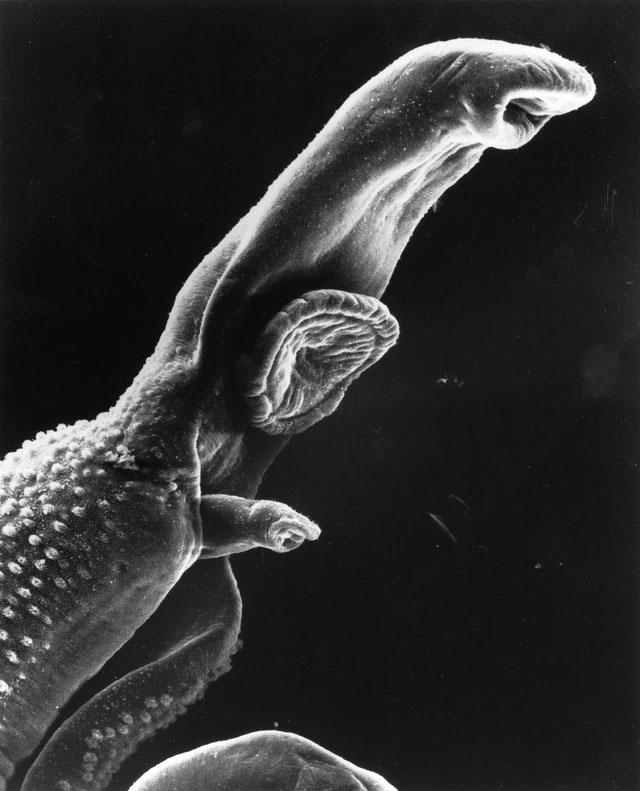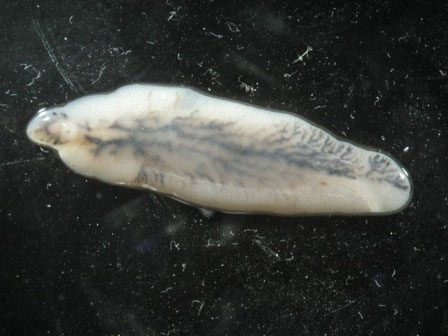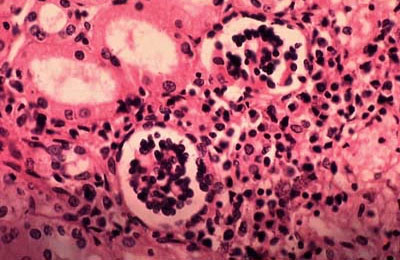Life comes in many forms and varieties. Sometimes, there are species that harness sunlight to generate energy—like plants, while others choose to parasitize and harm their hosts.
Top 6 Dangerous Parasites Discovered in Humans
1. Blood Fluke

These notorious parasites cause a condition known as schistosomiasis.
One little-known fact is that Napoleon once faced an infection caused by blood flukes. These infamous parasites cause a condition known as schistosomiasis (also called bilharzia) and to make matters worse, there are over half a dozen species of the genus Schistosoma that consider humans as their hosts.
Infection occurs through water contaminated with Schistosoma larvae (known as cercariae). The larvae invade the host’s skin, then travel through the bloodstream to the liver, intestines, urinary tract, and many other parts of the body. Common symptoms of schistosomiasis include skin itching, abdominal pain, and diarrhea… However, in later stages, it can lead to serious health issues such as liver enlargement, blood in urine, prostate infections, bladder scarring, and infertility.
According to the WHO, over 230 million cases of schistosomiasis have been reported since the disease was first identified in 1851. Fortunately, at present, infections can be easily treated with a type of anti-parasitic medication.
2. Dracunculus (Guinea Worm)

This parasite causes Guinea Worm Disease (GWD) in humans.
This spaghetti-like roundworm parasite may seem harmless, but the reality is quite the opposite. The parasite causes Guinea Worm Disease (GWD) in humans, transmitted when a person drinks water contaminated with water fleas containing Dracunculus medinensis larvae. Symptoms of the disease typically begin to appear about a year after infection when the larvae mature.
The mature roundworm releases its larvae and exits the skin of the infected person by causing blister-like sores. Patients experience pain and burning sensations on these blisters and must frequently wash them with water, causing the blisters to burst and releasing the parasitic larvae. This process can also lead to severe bacterial infections, which can be life-threatening.
Surprisingly, there are no modern drugs or vaccines that can effectively treat GWD. Only when the mature dracunculus emerges through the sores can patients remove the parasite from their bodies.
Dracunculus was previously endemic to a vast region of Africa and Eurasia, but now it is only endemic in five countries: Chad, Ethiopia, Mali, South Sudan, and Angola, with most cases occurring in Chad and Ethiopia.
3. Tapeworm

The most common habitat for them is in the intestines of humans.
Also known as Taenia, this ribbon-shaped worm can cause seizures if it forms cysts within your brain. However, its most common habitat is in the intestines of humans (or pets).
Taenia solium larvae can enter a person’s body when they consume contaminated water or undercooked pork or beef containing tapeworm cysts or eggs.
Not everyone infected with tapeworms experiences seizures; this only occurs when Taenia larvae affect the central nervous system in humans. In such cases, it is nearly impossible to diagnose or treat tapeworm infections as patients typically show no symptoms. Usually, this species affects the small intestine, causing constipation, diarrhea, abdominal pain, etc. In more severe cases, it can lead to seizures, blindness, meningitis, and many other neurological problems. Tapeworms are responsible for 30% of epilepsy cases in many endemic areas where humans and free-range pigs live closely together.
Tapeworms are also one of the most common dangerous parasites. It is estimated that 5% of Americans have tapeworms, but most are unaware of this.
4. Liver Fluke

The common liver flukes are Fasciola hepatica and Fasciola gigantica.
The infection is known as fascioliasis and occurs when an individual consumes water or raw plants containing liver fluke larvae. Fasciola hepatica and Fasciola gigantica are the most common liver fluke parasites found in humans. They primarily infect the bile ducts and liver, but in rare cases, the brain, pancreas, and eyes can also be affected. Studies show that liver fluke disease threatens the health of over 150 million people worldwide.
However, fascioliasis is not a fatal infection and is mainly found in sheep, but if infected, the parasite can remain in your body for up to 30 years and can cause frequent digestive health issues. Symptoms of liver fluke infection can range from fever and nausea to gallbladder inflammation and bile duct obstruction.
5. Leishmania chagasi and Leishmania donovani

95% of patients with visceral leishmaniasis will die if not treated promptly.
Both of these protozoan species can cause a frightening disease known as visceral leishmaniasis in humans. During the infection, the spleen, bone marrow, and liver are severely affected and swollen. Consequently, infected individuals experience reduced immunity and blood cell counts, leading to anemia, weight loss, prolonged fever, and many other bodily issues.
According to the WHO, 95% of patients with visceral leishmaniasis will die if not treated promptly. Additionally, there are two other types of leishmaniasis found in humans called mucocutaneous leishmaniasis and cutaneous leishmaniasis, which cause infections in mucous membranes and skin ulcers, respectively. However, both of these infections are not considered fatal.
6. Acanthamoeba

About 95% of patients with GAE are killed by the amoeba.
This type of amoeba parasite causes granulomatous amoebic encephalitis (GAE), a disease that leads to brain swelling. About 95% of patients with GAE are killed by the amoeba. However, not everyone infected with Acanthamoeba develops GAE, and some patients may never show any symptoms.
The parasite can be found in soil, chlorinated swimming pools, tap water, on contact lenses, bottled water, and air conditioning units, and it can enter the human body through the eyes, sores, wounds, and nasal cavities.
When Acanthamoeba infects the eyes, this condition is known as keratitis. Patients face severe eye pain, blurred vision, redness, corneal ulcers, and many other eye-related issues. In this case, early diagnosis is crucial because if left untreated, patients may suffer permanent blindness due to the infection.


















































